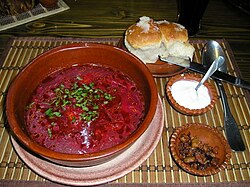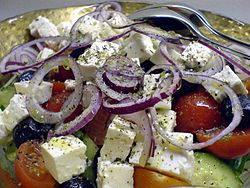
This is a list of European cuisines. A cuisine is a characteristic style of cooking practices and traditions, [1] often associated with a specific culture. European cuisine refers collectively to the cuisines of Europe. [2] European cuisine includes cuisines of Europe, but can arguably also include non-indigenous cuisines of North America, Australasia, Oceania, and Latin America, which derive substantial influence from European settlers in those regions.
Contents
- Central European cuisine
- Eastern European cuisine
- Northern European cuisine
- Southern European cuisine
- Western European cuisine
- Regional cuisines
- Historical cuisines
- See also
- References
The cuisines of European countries are diverse by themselves, although there are common characteristics that distinguishes European cooking from cuisines of Asian countries [3] and others. Compared with traditional cooking of Asian countries, for example, meat is more prominent and substantial in serving-size. [4] Wheat-flour bread has long been the most common sources of starch in this cuisine, along with pasta, dumplings and pastries, although the potato has become a major starch plant in the diet of Europeans and their diaspora since the European colonization of the Americas.
































